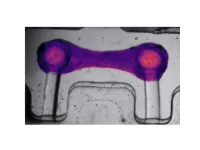(Press-News.org) A Pulse of Innovation: AI at the Service of Heart Research
Columbia biomedical engineers use AI to build a transformative new tool to study and diagnose heart function
Understanding heart function and disease, as well as testing new drugs for heart conditions, has long been a complex and time-consuming task. A promising way to study disease and test new drugs is to use cellular and engineered tissue models in a dish, but existing methods to study heart cell contraction and calcium handling require a good deal of manual work, are prone to errors, and need expensive specialized equipment. There clearly is a critical medical need for a more efficient, accurate, and accessible way to study heart function, using a methodology based on artificial intelligence (AI) and machine learning.
BeatProfiler, new tool to rapidly analyze heart cell function
Researchers at Columbia Engineering unveiled a groundbreaking new tool today that addresses these challenges head-on. BeatProfiler is a comprehensive software that automates the analysis of heart cell function from video data and is the first system to integrate the analysis of different heart function indicators, such as contractility, calcium handling, and force output into one tool, speeding up the process significantly and reducing the chance for errors. BeatProfiler enabled the researchers to not only distinguish between different diseases and levels of their severity but also to rapidly and objectively test drugs that affect heart function. The study was published on April 8 in IEEE Open Journal of Engineering in Medicine and Biology.
“This is truly a transformative tool,” said project leader Gordana Vunjak-Novakovic, University Professor and the Mikati Foundation Professor of Biomedical Engineering, Medical Sciences, and Dental Medicine at Columbia. “It’s fast, comprehensive, automated, and compatible with a broad range of computer platforms so it is easily accessible to investigators and clinicians.”
Software is open-source
The team, which included Barry Fine, assistant professor of medicine (in Cardiology) at Columbia University Irving Medical Center, elected not to file a patent application, and instead are offering the AI software as open source, so it can be directly used -- for free -- by any lab. They believe that this is important for disseminating the results of their research, as well as for getting feedback from users in academic, clinical, and commercial labs that can help the team to further refine the software.
The need to diagnose heart disease quickly and accurately
This project was driven, like much of Vunjak-Novakovic’s research, by a clinical need to diagnose heart diseases more quickly and accurately. This was a project that was several years in the making in which the team added different features piece by piece. While the overarching need was to develop a tool that could better capture the function of the cardiac models that the team was building to study cardiac diseases and assess the efficacy of potential therapeutics, the researchers had an urgent need to quickly and accurately assess the function of their cardiac models in real-time.
As the lab was making more and more cardiac tissues through innovations such as milliPillar and multiorgan tissue models, the increased capabilities of the tissues required the researchers to develop a method to more rapidly quantify the function of cardiomyocytes (heart muscle cells) and tissues to enable studies exploring genetic cardiomyopathies, cosmic radiation, immune-mediated inflammation, and drug discovery.
Collaborators in software development, machine learning, and more
In the last year and a half, lead author Youngbin Kim and his coauthors developed a graphical user interface (GUI) on top of the code so that biomedical researchers with no coding expertise could easily analyze the data with just a few clicks. This brought together experts in software development (for the GUI development), machine learning (for developing computer vision technology and disease/drug classifiers), signal processing (for processing contractile and calcium signals), engineering (translating pillar deflection on the cardiac platform to mechanical force), and user experience by lab members (to give feedback for improvements in the interface).
The results
The study showed that BeatProfiler could accurately analyze cardiomyocyte function, outperforming existing tools by being faster -- up to 50 times in some cases -- and more reliable. It detected subtle changes in engineered heat tissue force response that other tools might miss.
“This level of analysis speed and versatility is unprecedented in cardiac research,” said Kim, a PhD candidate in Vunjak-Novakovic’s lab at Columbia Engineering. “Using machine learning, the functional measurements analyzed by BeatProfiler helped us to distinguish between diseased and healthy heart cells with high accuracy and even to classify different cardiac drugs based on how they affect the heart.”
What’s next
The team is working to expand BeatProfiler’s capabilities for new applications in heart research, including a full spectrum of diseases that affect the pumping of the heart, and drug development. To ensure that BeatProfiler can be applied to a wide variety of research questions, they are testing and validating its performance across additional in vitro cardiac models, including different engineered heart tissue models. They are also refining their machine-learning algorithm to extend and generalize its use to a variety of heart diseases and drug effect classification. The long-term goal is to adapt BeatProfiler to pharmaceutical settings to speed up the testing of hundreds of thousands of candidate drugs at once.
###
About the Study
Journal: IEEE Open Journal of Engineering in Medicine and Biology
The study is titled “BeatProfiler: Multimodal in Vitro Analysis of Cardiac Function Enables Machine Learning Classification of Diseases and Drugs.”
Authors are: Youngbin Kim, Kunlun Wang, Roberta I. Lock, Trevor R. Nash, Sharon Fleischer, Bryan Z. Wang, and Gordana Vunjak-Novakovic, Department of Biomedical Engineering, Columbia Engineering; and Barry M. Fine, Department of Medicine, Division of Cardiology, Columbia University Medical Center.
The work of Gordana Vunjak-Novakovic was supported by the National Institutes of Health under Grants P41 EB027062 and 5R01HL076485-15, in part by the National Science Foundation under Grant NSF1647837, and in part by National Aeronautics and Space Administration under Grant NNX16AO69A. The work of Barry M. Fine was supported in part by the National Institutes of Health under Grant R01HL166387 and in part by Abramova Foundation.
The authors declare no financial or other conflicts of interest.
###
LINKS:
Paper: https://doi.org/10.1109/OJEMB.2024.3377461
DOI: 10.1109/OJEMB.2024.3377461
###
END
A pulse of innovation: AI at the service of heart research
Columbia biomedical engineers use AI to build a transformative new tool to study and diagnose heart function
2024-04-08
ELSE PRESS RELEASES FROM THIS DATE:
Targeting vulnerability in B-cell development leads to novel drug combination for leukemia
2024-04-08
Despite having an overall survival rate of 94%, B-cell acute lymphoblastic leukemia (B-ALL), the most common childhood cancer, can prove challenging to treat, with survival among relapsed or resistant cases falling between 30-50%. Recent work by St. Jude Children’s Research Hospital scientists discovered which tumor cells resist treatment and why. This enabled the rational design of a combination therapy that better controlled high-risk subtypes of B-ALL in mouse models. The findings were published today in Cancer Cell.
“We found a new explanation of B-ALL ...
People make more patient decisions when shown the benefits first
2024-04-08
Key takeways
UCLA psychologists asked experiment participants to choose to receive $40 in seven days or $60 in 30 days, for example, under a variety of time constraints.
The experiment showed that people tend to make more impulsive decisions if they think about time delays first, and more patient decisions if they think about the greater reward associated with waiting longer.
The findings could be applied where people are being encouraged to make life choices that will benefit them in the long run, such as eating healthier, exercising or saving for retirement, by emphasizing the future large rewards and deemphasizing ...
New diagnostic tool achieves accuracy of PCR tests with faster and simpler nanopore system
2024-04-08
EMBARGOED UNTIL APRIL 8, 2024 AT 3:00 PM U.S. ET/ 12:00 PM PT
Over the past four years, many of us have become accustomed to a swab up the nose to test for COVID-19, using at-home rapid antigen tests or the more accurate clinic-provided PCR tests with a longer processing time. Now a new diagnostic tool developed by UC Santa Cruz Distinguished Professor of Electrical and Computer Engineering Holger Schmidt and his collaborators can test for SARS-CoV-2 and Zika virus with the same or better accuracy as high-precision PCR tests in a matter of hours.
In a new paper in the journal Proceedings of the National Academy of Sciences, Schmidt ...
Pregnancy accelerates biological aging in a healthy, young adult population
2024-04-08
Pregnancy may carry a cost, reports a new study from the Columbia University Mailman School of Public Health. The research, carried out among 1735 young people in the Philippines, shows that women who reported having been pregnant looked biologically older than women who had never been pregnant, and women who had been pregnant more often looked biologically older than those who reported fewer pregnancies. Notably, the number of pregnancies fathered was not associated with biological aging among same-aged cohort ...
Different means to the same end: How a worm protects its chromosomes
2024-04-08
University of Michigan researchers have discovered that a worm commonly used in the study of biology uses a set of proteins unlike those seen in other studied organisms to protect the ends of its DNA.
In mammals, shelterin is a complex of proteins that "shelters" the ends of our chromosomes from unraveling or fusing together. Keeping chromosomes from fusing together is an important job: chromosomes carry our body's DNA. If chromosome ends fuse, or if they fuse with other chromosomes, ...
ADA Forsyth scientists discover new phage resistance mechanism in phage-bacterial arms race
2024-04-08
One of the most abundant and deadliest organisms on earth is a virus called a bacteriophage (phage). These predators have lethal precision against their targets – not humans, but bacteria. Different phages have evolved to target different bacteria and play a critical role in microbial ecology. Recently, ADA Forsyth scientists exploring the complex interactions of microbes in the oral microbiome discovered a third player influencing the phage-bacterial arms race – ultrasmall bacterial parasites, called Saccharibacteria or TM7.
In the study, which appeared in Proceedings of the National Academy of Sciences ...
Deep parts of Great Barrier Reef ‘insulated’ from global warming – for now
2024-04-08
Some deeper areas of the Great Barrier Reef are insulated from harmful heatwaves – but that protection will be lost if global warming continues, according to new research.
High surface temperatures have caused mass “bleaching” of the Great Barrier Reef in five of the last eight years, with the latest happening now.
Climate change projections for coral reefs are usually based on sea surface temperatures, but this overlooks the fact that deeper water does not necessarily experience the same warming as that at the surface.
The new study – ...
How climate change will impact food production and financial institutions
2024-04-08
Researchers at the University of California San Diego School of Global Policy and Strategy have developed a new method to predict the financial impacts climate change will have on agriculture, which can help support food security and financial stability for countries increasingly prone to climate catastrophes.
The study, published today in the Proceedings of the National Academy of Sciences, uses climate and agricultural data from Brazil. It finds that climate change has a cascading effect on farming, leading to increased loan defaults for ...
MSU researchers find more action needed to prevent arthritis
2024-04-08
MSU has a satellite uplink/LTN TV studio and Comrex line for radio interviews upon request.
EAST LANSING, Mich. – The prevalence of early knee osteoarthritis (OA) symptoms faced by patients after anterior cruciate ligament (ACL) reconstruction is staggering — but not much is being done to address it according to new research published by scholars from Michigan State University’s Department of Kinesiology.
The study – published by the Journal of Athletic ...
Americans are bad at recognizing conspiracy theories when they believe they’re true
2024-04-08
Conspiracy theorists get a bad rap in popular culture, yet research has shown that most Americans believe conspiracy theories of some sort. Why then, if most of us believe conspiracies, do we generally think of conspiracy theorists as loony?
New research from the University of Illinois Chicago found that it’s because people are quite bad at identifying what is or isn’t a conspiracy theory when it’s something they believe. The finding held true whether people self-identified as being liberal ...
LAST 30 PRESS RELEASES:
Numbers in our sights affect how we perceive space
SIMJ announces global collaborative book project in commemoration of its 75th anniversary
Air pollution exposure and birth weight
Obstructive sleep apnea risk and mental health conditions among older adults
How talking slows eye movements behind the wheel
The Ceramic Society of Japan’s Oxoate Ceramics Research Association launches new international book project
Heart-brain connection: international study reveals the role of the vagus nerve in keeping the heart young
Researchers identify Rb1 as a predictive biomarker for a new therapeutic strategy in some breast cancers
Survey reveals ethical gaps slowing AI adoption in pediatric surgery
Stimulant ADHD medications work differently than thought
AI overestimates how smart people are, according to HSE economists
HSE researchers create genome-wide map of quadruplexes
Scientists boost cell "powerhouses" to burn more calories
Automatic label checking: The missing step in making reliable medical AI
Low daily alcohol intake linked to 50% heightened mouth cancer risk in India
American Meteorological Society announces Rick Spinrad as 2026 President-Elect
Biomass-based carbon capture spotlighted in newly released global climate webinar recording
Illuminating invisible nano pollutants: advanced bioimaging tracks the full journey of emerging nanoscale contaminants in living systems
How does age affect recovery from spinal cord injury?
Novel AI tool offers prognosis for patients with head and neck cancer
Fathers’ microplastic exposure tied to their children’s metabolic problems
Research validates laboratory model for studying high-grade serous ovarian cancer
SIR 2026 delivers transformative breakthroughs in minimally invasive medicine to improve patient care
Stem Cell Reports most downloaded papers of 2025 highlight the breadth and impact of stem cell research
Oxford-led study estimates NHS spends around 3% of its primary and secondary care budget on the health impacts of heat and cold in England
A researcher’s long quest leads to a smart composite breakthrough
Urban wild bees act as “microbial sensors” of city health.
New study finds where you live affects recovery after a hip fracture
Forecasting the impact of fully automated vehicle adoption on US road traffic injuries
Alcohol-related hospitalizations from 2016 to 2022
[Press-News.org] A pulse of innovation: AI at the service of heart researchColumbia biomedical engineers use AI to build a transformative new tool to study and diagnose heart function






